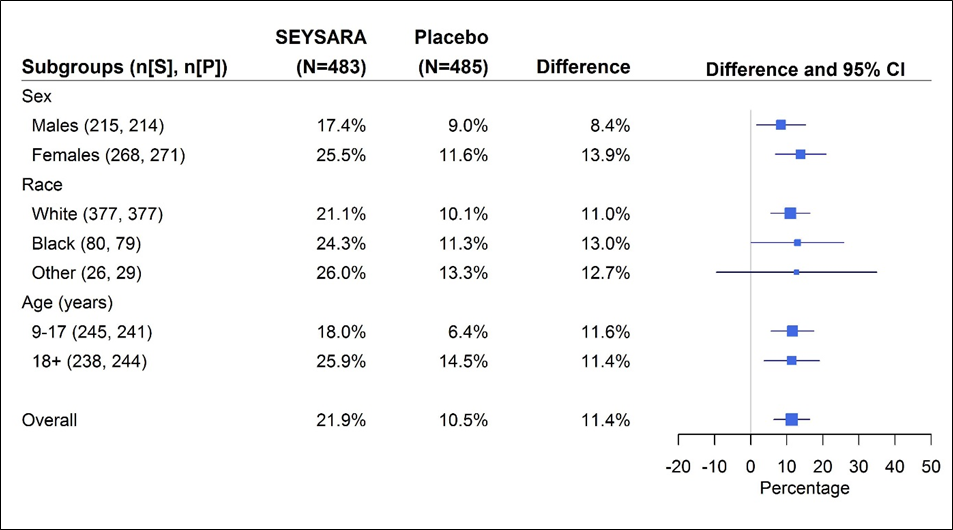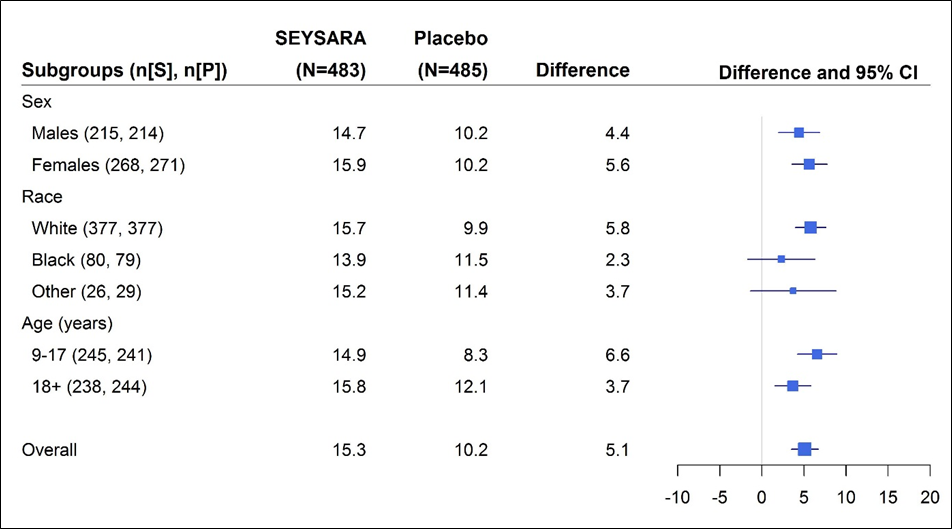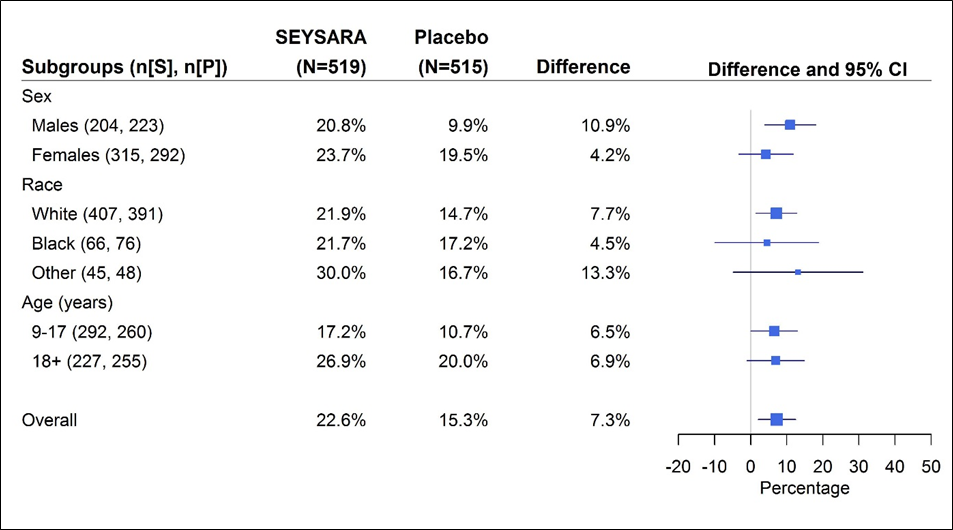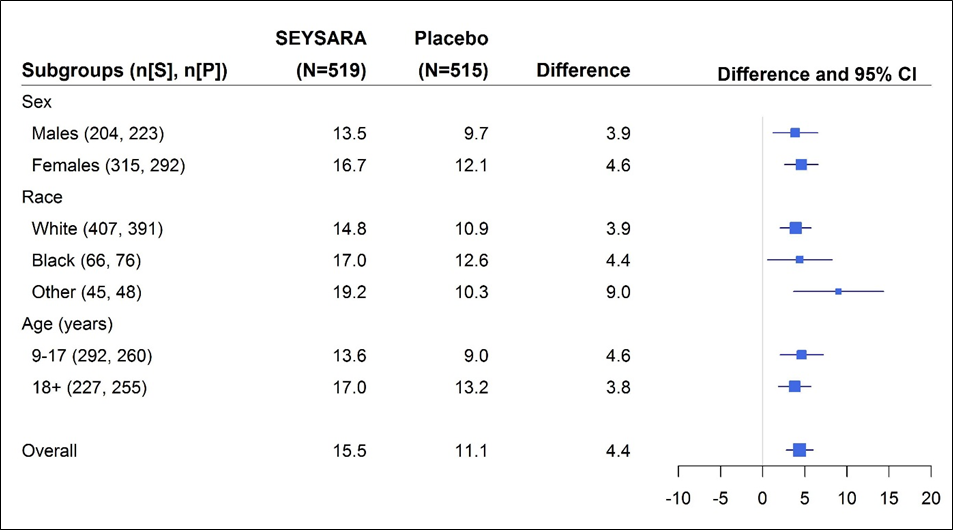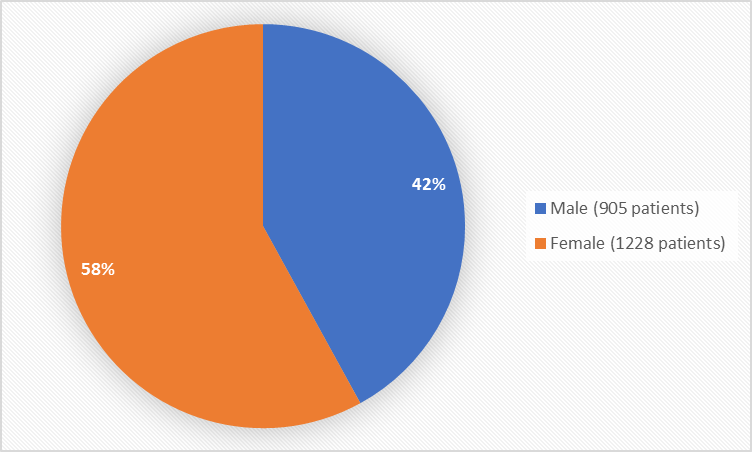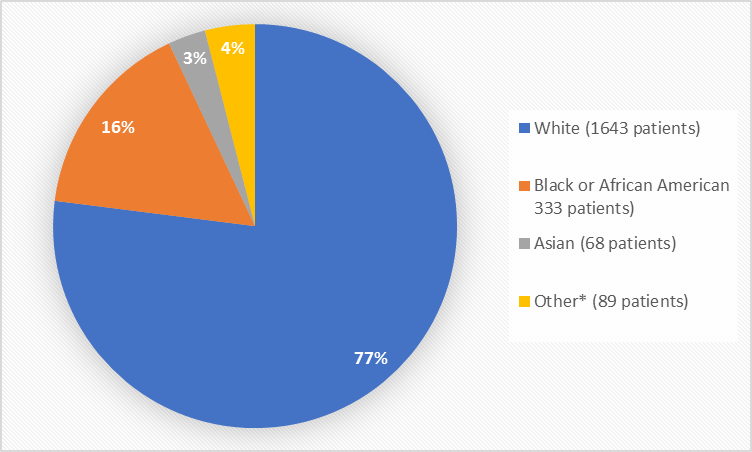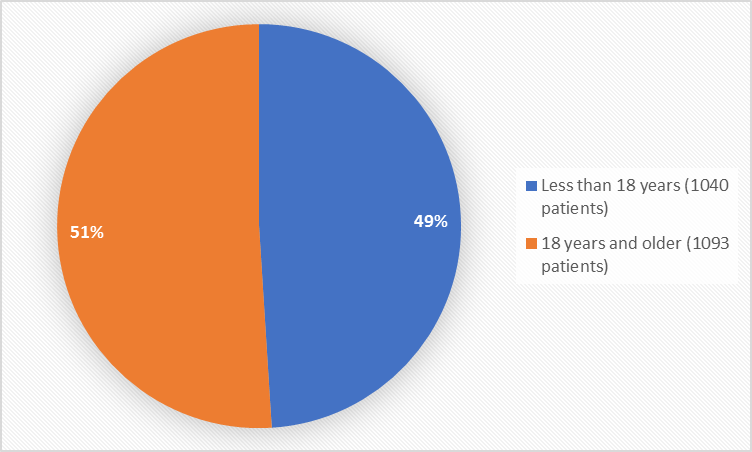Drug Trials Snapshot: SEYSARA
HOW TO USE THIS SNAPSHOT
The information provided in Snapshots highlights who participated in the clinical trials that supported the FDA approval of this drug, and whether there were differences among sex, race, and age groups. The “MORE INFO” bar shows more detailed, technical content for each section. The Snapshot is intended as one tool for consumers to use when discussing the risks and benefits of the drugs.
LIMITATIONS OF THIS SNAPSHOT:
Do not rely on Snapshots to make decisions regarding medical care. Always speak to your health provider about the risks and benefits of a drug. Refer to the SEYSARA Package Insert for complete information.
SEYSARA (sarecycline)
SAY’sara
Allergan USA, Inc.
Approval date:October 1, 2018
DRUG TRIALS SNAPSHOT SUMMARY:
What is the drug for?
SEYSARA is a drug used to treat certain types of moderate to severe acne vulgaris in patients 9 years and older.
Acne vulgaris is a skin disease characterized by oily skin, blackheads or whiteheads, pimples, and sometimes scarring.
How is this drug used?
SEYSARA is a tablet taken by mouth once daily. The dose is based on body weight.
What are the benefits of this drug?
More patients achieved a reduction in the number of inflammatory acne (pimples) and clear or almost clear skin after 12 weeks of treatment with SEYSARA in comparison to those who were treated with placebo.
What are the benefits of this drug (results of trials used to assess efficacy)?
The table below summarizes efficacy results for the evaluated patients in Trials 1 and 2. The co-primary endpoints were the percentage of patients with Investigator’s Global Assessment (IGA) score of clear (0) or almost clear (1) and 2-point decrease from baseline and the absolute reduction from baseline in inflammatory lesion counts at week 12.
Table 2. Clinical Efficacy of SEYSARA at Week 12
|
|
Trial 1 |
Trial 2 |
||
|---|---|---|---|---|
|
|
SEYSARA |
Placebo |
SEYSARA |
Placebo |
|
Investigator’s Global Assessment |
||||
|
IGA Success |
21.9% |
10.5% |
22.6% |
15.3% |
|
Inflammatory Lesions |
||||
|
Mean absolute reduction |
15.3 |
10.2 |
15.5 |
11.1 |
|
Mean percent reduction |
52.2% |
35.2% |
50.8% |
36.4% |
SEYSARA Prescribing Information
Were there any differences in how well the drug worked in clinical trials among sex, race and age?
- Sex: SEYSARA worked similarly in males and females.
- Race: SEYSARA worked similarly in White and Black or African American patients. The number of patients in other races was limited; therefore, differences in how SEYSARA worked among other races could not be determined.
- Age: SEYSARA worked similarly among patients younger than and older than 18 years of age.
Were there any differences in how well the drug worked in clinical trials among sex, race, and age groups?
The figures below summarize efficacy results by sex, race, and age.
Figure 4. IGA Success(1) at Week 12 by Sex, Race, and Age for Trial 1 [ITT(2)]
(1)Success is defined as an IGA score of 0 or 1 with at least a 2-point decrease from baseline.
(2)Intent-to-Treat (ITT) population: all randomized patients. Missing data was imputed using multiple imputation (MI). The values displayed are the averages over the 20 imputed datasets.
n[S]= number of patients in SEYSARA subgroup; n[P] number of patients in placebo subgroup
FDA Review
Figure 5. Absolute Change from Baseline in Inflammatory Lesion Counts at Week 12 by Sex, Race, and Age for Trial 1 [ITT(1)]
(1)Intent-to-Treat (ITT) population: all randomized patients. Missing data was imputed using multiple imputation (MI). The values displayed are the averages over the 20 imputed datasets.
n[S]= number of patients in SEYSARA subgroup; n[P] number of patients in placebo subgroup
FDA Review
Figure 6. IGA Success(1) at Week 12 by Sex, Race, and Age for Trial 2 [ITT(2)]
(1)Success is defined as an IGA score of 0 or 1 with at least a 2-point decrease from baseline.
(2)Intent-to-Treat (ITT) population: all randomized patients. Missing data was imputed using multiple imputation (MI). The values displayed are the averages over the 20 imputed datasets.
n[S]= number of patients in SEYSARA subgroup; n[P] number of patients in placebo subgroup
FDA Review
Figure 7. Absolute Change from Baseline in Inflammatory Lesion Counts at Week 12 by Sex, Race, and Age for Trial 2 [ITT(1)]
(1)Intent-to-Treat (ITT) population: all randomized patients. Missing data was imputed using multiple imputation (MI). The values displayed are the averages over the 20 imputed datasets.
n[S]= number of patients in SEYSARA subgroup; n[P] number of patients in placebo subgroup
FDA Review
What are the possible side effects?
SEYSARA like other antibacterial medications called tetracyclines may cause serious side effects including:
- harm to an unborn baby
- permanently turning child’s teeth yellow, gray, or brown from birth to 8 years of age
- slow bone growth
- diarrhea caused by an infection called clostridium difficile
- light-headedness, dizziness, a spinning feeling (vertigo)
- increased pressure around the brain (intracranial hypertension)
- sensitivity to sunlight (photosensitivity)
The most common side effect of SEYSARA is nausea.
What are the possible side effects (results of trials used to assess safety)?
The only adverse drug reaction that was reported in at least 1% of patients was nausea,
SEYSARA (3.1%) versus placebo (2.0%).
SEYSARA Prescribing Information
Were there any differences in side effects among sex, race and age?
- Sex: The occurrence of side effects was similar among males and females.
- Race: The occurrence of side effects was similar in White and Black or African American patients. The number of patients in other races was limited; therefore, differences in the occurrence of side effects among other races could not be determined
- Age: The occurrence of side effects was similar among patients younger than and older than 18 years of age.
Were there any differences in side effects of the clinical trials among sex, race, and age groups?
The table below summarizes the occurrence of the most common adverse reaction, nausea, by subgroup.
Table 3. Subgroup Analysis of Nausea (safety population)
|
Demographic Characteristic |
SEYSARA |
Placebo |
|---|---|---|
|
Sex |
||
|
Male |
7/446 (2) |
8/459 (2) |
|
Female |
27/618 (4) |
14/610 (2) |
|
Race |
||
|
White |
16/826 (2) |
17/817 (2) |
|
Black or African American |
14/164 (9) |
3/169 (2) |
|
Asian |
2/36 (6) |
0/32 (0) |
|
American Indian or Alaska Native |
1/7 (< 1) |
1/13 (< 1) |
|
Other |
1/30 (< 1) |
1/38 (< 1) |
|
Age Group |
||
|
< 18 years |
11/512 (2) |
13/528 (2) |
|
> 18 years |
23/552 (4) |
9/541 (2) |
Clinical Trial Data
WHO WAS IN THE CLINICAL TRIALS?
Who participated in the clinical trials?
The FDA approved SEYSARA based on evidence from three clinical trials (Trial 1/NCT02320149, Trial 2/NCT02322866, Trial 3/ NCT01628549) of 2133 patients with moderate to severe acne vulgaris. The trials were conducted at 148 sites in the United States.
The population that provided data for evaluation of side effects (safety population) is presented below. Demographics of the patients who provided data for evaluation of benefits (efficacy population) are presented in Table 5, under the MORE INFO section.
Figure 1 summarizes how many males and females were in the clinical trials used to evaluate safety.
Figure 1. Baseline Demographics by Sex
FDA Review
Figure 2 summarizes the percentage of patients by race in the clinical trials used to evaluate safety.
Figure 2. Baseline Demographics by Race
*Other includes American Indian or Alaska Native, Missing
FDA Review
Table 1. Demographics of Safety Trials by Race
|
Race |
Number of Patients |
Percentage of Patients |
|---|---|---|
|
White |
1643 |
77% |
|
Black or African American |
333 |
16% |
|
Asian |
68 |
3% |
|
Other* |
88 |
4% |
|
Missing |
1 |
Less than 1% |
*Other includes American Indian or Alaska Native
FDA Review
Figure 3 summarizes the percentage of patients by age in the clinical trials used to evaluate safety.
Figure 3. Baseline Demographics by Age
FDA Review
Who participated in the trials?
The tables below summarize demographics of the safety population and the intent-to-treat (ITT) population.
Table 4. Baseline Demographics (Safety Population)
|
SEYSARA |
Placebo |
Total |
|
|---|---|---|---|
|
Sex |
|||
|
Male |
446 (42%) |
459 (43%) |
905 (42%) |
|
Female |
618 (58%) |
610 (57%) |
1228 (58%) |
|
Race |
|||
|
White |
826 (78%) |
817 (76%) |
1643 (77%) |
|
Black or African American |
164 (15%) |
169 (16%) |
333 (16%) |
|
Asian |
36 (3%) |
32 (3%) |
68 (3%) |
|
American Indian or Alaska Native |
7 (< 1%) |
13 (1%) |
20 (< 1%) |
|
Other |
30 (3%) |
38 (4%) |
68 (3%) |
|
Missing |
1 (<1%) |
0 |
1 (<1%) |
|
Age |
|||
|
Mean (SD) |
20.0 (6.6) |
19.8 (6.7) |
19.9 (6.7) |
|
Median |
18.0 |
18.0 |
18.0 |
|
Range |
9 to 45 |
10 to 45 |
9 to 45 |
|
Age Group |
|||
|
9-11 years |
11 (1%) |
10 (1%) |
21 (1%) |
|
12-17 years |
501 (47%) |
518 (48%) |
1019 (48%) |
|
≥ 18 years |
552 (52%) |
541 (51%) |
1093 (51%) |
|
Ethnicity |
|||
|
Hispanic |
289 (27%) |
282 (26%) |
571 (27%) |
|
Non-Hispanic |
774 (73%) |
787 (74%) |
1561 (73%) |
|
Missing |
1 (<1%) |
0 |
1 (<1%) |
|
Region |
|
|
|
|
United States |
1064 (100%) |
1069 (100%) |
2133 (100%) |
Clinical Trial Data
Table 5. Baseline Demographics Intent-to Treat (ITT) Population
|
Trial 1 |
Trial 2 |
|||
|---|---|---|---|---|
|
SEYSARA |
Placebo |
SEYSARA |
Placebo |
|
|
Sex |
||||
|
Male |
215 (45%) |
214 (44%) |
204 (39%) |
223 (43%) |
|
Female |
268 (55%) |
271 (56%) |
315 (61%) |
292 (57%) |
|
Race |
||||
|
White |
377 (78%) |
377 (78%) |
407 (79%) |
391 (76%) |
|
Black or African American |
80 (17%) |
79 (16%) |
66 (13%) |
76 (15%) |
|
Asian |
11 (2%) |
9 (2%) |
23 (4%) |
21 (4%) |
|
Other |
15 (3%) |
20 (4%) |
22 (4%) |
27 (5%) |
|
Missing |
0 |
0 |
1 (<1%) |
0 |
|
Age |
||||
|
Mean (SD) |
19.6 (6.5) |
19.8 (6.9) |
20.4 (6.7) |
19.7 (6.4) |
|
Median |
17.0 |
18.0 |
18.0 |
17.0 |
|
Range |
10 to 45 |
10 to 45 |
9 to 44 |
10 to 44 |
|
Age Group |
||||
|
9-11 years |
4 (1%) |
6 (1%) |
7 (1%) |
4 (1%) |
|
12-17 years |
241 (50%) |
235 (49%) |
285 (55%) |
256 (50%) |
|
≥ 18 years |
238 (49%) |
244 (50%) |
227 (44%) |
255 (49%) |
|
Ethnicity |
||||
|
Hispanic |
144 (30%) |
143 (29%) |
131 (25%) |
122 (24%) |
|
Non-Hispanic |
339 (70%) |
342 (71%) |
387 (75%) |
393 (76%) |
|
Missing |
0 |
0 |
1 (<1%) |
0 |
|
Region |
|
|
|
|
|
United Sates |
483 (100%) |
485 (00%) |
519 (100%) |
515 (100%) |
FDA Review
How were the trials designed?
The benefit and side effects of SEYSARA were evaluated in three clinical trials of patients 9 to 45 years of age with moderate to severe acne vulgaris.
Trials 1 and 2 enrolled patients 9 to 45 years of age with moderate to severe facial acne vulgaris. Patients received SEYSARA or placebo tablets by mouth once daily for 12 weeks. Neither the patients nor the health care providers knew which treatment was being given until after the trial was completed. The benefit of SEYSARA in comparison to placebo was assessed after 12 weeks of treatment using the Investigator’s Global Assessment [IGA] score that measures the severity of disease (on a scale from 0 to 4) and a decrease in the number of inflammatory acne (pimples).
Trial 3 enrolled patients 12 to 45 years of age with moderate to severe facial acne vulgaris. Patients received one of three doses of SEYSARA capsules by mouth for 12 weeks. Patients in Trial 3 were primarily evaluated for side effects.
How were the trials designed?
The safety and efficacy of SEYSARA were established in 3 clinical trials.
Trials 1 and 2 were randomized, double-blind, placebo-controlled clinical trials designed to evaluate SEYSARA in patients 9 years and older with moderate to severe facial acne. Patients were randomized to receive either placebo or SEYSARA (60 mg, 100 mg, or 150 mg tablets [based on weight]) once daily for 12 weeks. The co-primary efficacy endpoints were the percentage of patients with Investigator’s Global Assessment (IGA) success and the absolute reduction from baseline in inflammatory lesion counts at week 12. IGA success was defined as a score of clear (0) or almost clear (1) and a 2-point decrease from baseline on IGA score at week 12.
Trial 3 was a randomized, double-blind, placebo-controlled, dose-ranging trial. Patients received SEYSARA supplied as 50 mg, 100 mg, or 200 mg formulated capsules. Patients were primarily evaluated for adverse events.
GLOSSARY
CLINICAL TRIAL: Voluntary research studies conducted in people and designed to answer specific questions about the safety or effectiveness of drugs, vaccines, other therapies, or new ways of using existing treatments.
COMPARATOR: A previously available treatment or placebo used in clinical trials that is compared to the actual drug being tested.
EFFICACY: How well the drug achieves the desired response when it is taken as described in a controlled clinical setting, such as during a clinical trial.
PLACEBO: An inactive substance or “sugar pill” that looks the same as, and is given the same way as, an active drug or treatment being tested. The effects of the active drug or treatment are compared to the effects of the placebo.
SUBGROUP: A subset of the population studied in a clinical trial. Demographic subsets include sex, race, and age groups.

